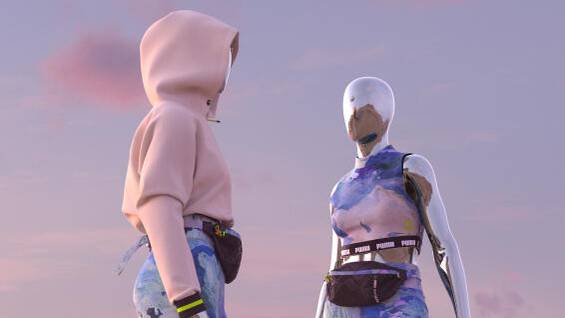A woman standing in a green meadow. She is wearing a dress made of iridescent fabric that seems to be blown by the wind. The iridescent surface of the gown makes it look like it’s made out of a soap bubble. You will not find anything like this in any retail store in the world. And certainly not in the wardrobe. What distinguishes the robe called “Iridescence” that Richard Ma gave to his wife Mary Raine is not only its shape, but also the fact that Mary Raine never wore it on her skin. The dress, which cost 8,000 euros and was designed by digital fashion company The Fabricant, only exists in the digital world. To slip, it took a photo montage. It went viral in 2019. Ma, the managing director of a California security firm, believes the investment has been particularly sustainable and, according to BBC News, is convinced that “in ten years everyone will be wearing digital fashion.”
In fact, digital fashion is no longer a luxury experience. Virtual accessories are at least part of everyday life for many people: just think of hats, wreaths or glasses that you can put as a filter on your Instagram or Snapchat photo. So-called “skins”, virtual items of clothing that you wear on your character, are popular in the gaming sector. They do not bring additional benefit to the game in question. However, they’re coveted enough to be a commercial model: Louis Vuitton, for example, designed the skins for “League of Legends” in 2019 and “Final Fantasy” in 2021, and Burberry and Balenciaga followed suit.
Digital looks should inspire followers
The idea has great future potential – that’s also the opinion of Judith Brakem and Lukas Stupbe of the University of Hamburg. In their “Virtual Accessories” research project, art history students deal with all aspects of immaterial clothing. Already today it is possible to send a photo or video of yourself to the company in question, which uses a graphics program to mount a piece of clothing on it. One such company is DressX, where you can get earrings or hats from $1. More complex parts cost more. The main areas of the application are social media, in order to impress followers with a new look.
In addition, the wardrobe in which one can move in digital spaces is already being considered. Their bearers are avatars, as they were mainly used in computer-generated films and video games in the past. The fashion world is already sending such creatures to the bottom of the catwalk. Perhaps the most famous example is Miquela Souza, also known as Lil Miquela on Instagram. The number was created in 2016 by the American startup Brud. Sousa was equipped as a model by luxury brands such as Prada or Moncler. On Instagram, the fictional character provides around three million people regular insights into her “life”. Intermediate agencies like Mutantboard or The Diigitals are virtual models, some posters use dolls like these to present their collections in videos, like Marc Cain at the beginning of the year.
Advantages and disadvantages of intangible clothing
What seems like an unnecessary gimmick has some advantages, first of all: sustainability. Because a piece of clothing that doesn’t need to be sewn, dyed, or mailed is not harmful to the environment. Signs of wear such as holes, cracks, or stains are a thing of the past. In addition, the coat room does not have to be functional, for example, you do not need to take into account comfort and weather resistance. “Digital fashion is something that happens a lot right now, that describes or influences moods and serves as an expression of personality,” says Judith Brakem. “And that works more powerfully in the virtual space.” One reason for this is that the laws of materialism do not apply: “For example, I can walk around in clouds,” says Judith Brachim, “or wear something that changes colors.” Stübbe adds, “The possibilities of accentuating one’s personality with clothing are actually limited by the wearer.” With immaterial clothing, you can live out your identity in a more precise and limitless way.”
Brachem and Stübbe also see a danger here: after all, there is a danger of getting lost in unreal worlds, especially if a specially created avatar is dressed. “It also becomes important when you start comparing the virtual world to the real world,” says Stübbe. Because compared to the computer-generated perfection and diversity of imaginary possibilities, reality rarely has a chance.

Expensive sneakers as unique digital items
In addition to the visible reasons, the value of the complex also plays a major role in some parts. For example, the Rtfkt brand sold more than 600 pairs of virtual sneakers for a total of $3.1 million in March 2021. Each pair was created as a non-fungible token, or NFT for short. NFTs are protected objects that cannot be copied or exchanged – one time digital.
“Especially with Generation Z and Generation X, life online is increasing. In addition, for example, virtual reality glasses are becoming more accessible to everyone,” says Brashim. Dive into unreal worlds becomes more realistic. Brachem and its research partner Stübbe currently see the virtual experience as the first big step in this direction, where an item of clothing is tried online and then ordered as a real version, as has already been possible with some eyeglass manufacturers. “But we can very well imagine that life will shift more to virtual space in the future,” says Stübbe. Meeting friends, attending courses – all this may soon be enough to wear appropriate pixel clothes.

“Certified gamer. Problem solver. Internet enthusiast. Twitter scholar. Infuriatingly humble alcohol geek. Tv guru.”





